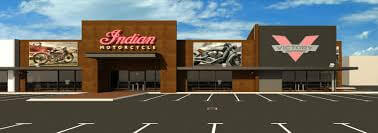Automotive > Motorcycles and Scooters
The 2010s have been a decade full of exciting development and growth for Indian Motorcycle. We’ve built a bright future upon our legendary past through technological innovations, rewarding partnerships, and an ever expanding lineup of authentic, iconic bikes.
2018 — The FTR 1200 inspired by the FTR750 is unveiled. The flat tracker for the street is here.
2018 — Travis Pastrana recreated Evel Knievel’s most famous jumps including the Caesars Palace fountain jump.
2018 — Indian Motorcycle Racing and Jared Mees secure back-to-back American Flat Track Twins Championships.
2017 — Indian Wrecking Crew member Jared Mees wins the American Flat Track Championship in the brand’s first year racing in over 60 years.
2017 — Lee Munro honors his Uncle Burt’s 1967 record by piloting a modern “Spirit of Munro” scout to a 190 mph run at the Bonneville Salt Flats.
2017 — Indian Motorcycle launches the Scout ® Bobber.
2016 — Indian Motorcycle introduces two new bikes — the Indian Springfield ® and Chieftain Dark Horse ® — along with Ride Command ® , the industry’s most advanced infotainment system.
2016 — Indian Motorcycle collaborates with Jack Daniels ® and Klock Werks Kustom Cycles to create the Limited Edition Jack Daniels Indian Springfield ® and Chief ® Vintage.
2016 — Indian Motorcycle accelerates its historic journey toward an official return to professional Flat Track Racing with the public debut of the Indian ® Scout ® FTR750.
2015 — Indian Motorcycle introduces the Chief Dark Horse ® and Scout ® Sixty.
2015 — Indian Motorcycle launches a multi-year partnership with Veteran’s Charity Ride to Sturgis TM.
2014 — Motorcycle.com names the Indian ® Chief ® as its 2014 Cruiser of the Year, also honoring the Chief ® Classic and Chief Vintage.
2014 — Indian Motorcycle adds the Roadmaster ® and iconic, all-new Scout ® to the lineup.
2013 — Indian Motorcycle unveils the powerful new Thunder Stroke ® 111 V-Twin engine.
2013 — The all-new Chief Classic, Chief Vintage, and Chieftain ® are introduced.
2011 — Polaris Industries announces the acquisition of Indian Motorcycle.
2000's Era
2000s: An Uncertain Future
Tumultuous Times for America’s First Motorcycle Company®
In 2003, Indian Motorcycle Company of America went bankrupt and ended production. The future of America’s first motorcycle company was uncertain.
Things started to turn around for Indian Motorcycle in 2008, when Stellican Ltd., a London-based private equity firm, purchased the Indian Motorcycle assets and established an Indian Motorcycle Company manufacturing facility in Kings Mountain, NC. A modest number of Indian Chief bikes with 105-ci V-twin engines were produced between 2008-2011. In 2011, Stellican sold Indian Motorcycle to Polaris Industries.
1990's Era
1990s: Resurrecting the Brand
Returning a Legend to its Former Glory
Brand-exclusive production of Indian Motorcycle models resumed in 1998. A merger of nine companies formed the Indian Motorcycle Company of America (IMCA), which opened a production facility in Gilroy, CA. The IMCA produced Chief, Scout, and Spirit models powered by engines acquired from S&S Cycle, Inc.
1970's Era
1970s: The End of An Era
The Death of Two Legends
Legendary motorcycle racer, dealer, distributor, magazine publisher, race promoter, author, and motorcycle manufacturer Floyd Clymer had been working to revive the defunct Indian Motorcycle brand since 1963.
Clymer died of a heart attack in 1970 and his attorney, Alan Newman, acquired the Indian Motorcycle trademark. Newman continued to sell small bikes carrying the Indian brand name. Most of these bikes were produced in Taiwan and had displacements between 50cc and 175cc. Other units were rebranded Italian mini-bikes. Sales declined throughout the 1970s and operations ceased in 1977.
1960's Era
1960s: The Pursuit of a Record
Burt Munro’s Historic Ride
In 1967, 68-year-old New Zealand native Burt Munro made motorcycle history by setting a new official land speed record—184.087 mph with unofficial top speed of 205.67 mph—when he raced his heavily modified 1920 Indian® Scout® Streamliner across the Bonneville Salt Flats in Utah.
Munro started claiming a number of New Zealand land speed records in the 1940s, and by the 1950s his Scout was too fast for New Zealand’s speed courses. He formed a new goal—to race on the flat, expansive Bonneville Salt Flats. Over the years, Munro and his Scout raced on the Bonneville Salt Flats nine times and set world records in three of them, culminating in his final trip—and record setting ride—in 1967. Burt Munro was inducted into the AMA Hall of Fame in 2006, a tribute to the pursuit begun eight decades earlier.
1950's Eras
1950s: The Rise of the Wrecking Crew
Dominating the World of Motorcycle Racing
The Indian Motorcycle Wrecking Crew TM—made up of legendary racers Bobby Hill, Bill Tuman, and Ernie Beckman—formed in the late 1940s, and by the early 1950s were dominating on both dirt and road courses. Among their signature wins were three straight Springfield Mile victories. Hill won the Springfield Mile in 1951 and 1952 and Tuman won it in 1953. The three also won season points titles and major events from coast to coast.
John Brockhouse replaced Ralph B. Rogers as president of Indian Motorcycle Company in 1950. Unfortunately, Indian Motorcycle Manufacturing Company ceased operations and discontinued production of all models in 1953. In 1955, Brockhouse Engineering purchased the rights to the Indian Motorcycle name and sold imported Royal Enfield models branded as Indian Motorcycle models until 1960.
1940's Era
1940s: A World at War
Indian Motorcycle Serves Its Country
From 1940 until 1945, Indian Motorcycle focused its efforts on contributing to the Allied cause in WWII, at first building motorcycles for the French government and, starting in 1941, producing the Model 841 for the U.S. Army. Very few bikes were built for consumers during this time.
In 1945, The Du Pont brothers sold the company to Ralph B. Rogers. Rogers also purchased the Torque Manufacturing Co., in part to utilize the talents of former Indian Motorcycle engineer G. Briggs Weaver, who worked for Torque and was designing several models Rogers wanted Indian Motorcycle to produce.
The first post-war lineup consisted only of the Indian Chief as design and production were ramped up for consumer models. In 1948, new vertical twin 440cc Indian Scout models and vertical single 220cc Indian® Arrow® models were introduced to compete with the growing number of lightweight foreign imports.
1930's Era
1930s: The Depression Years
Continued Growth in a Poor Economy
In 1930, E. Paul Du Pont sold his share of DuPont Automobile to Indian Motorcycle and bought a large share of Indian Motorcycle stock. E. Paul forced out the company’s existing management team and put Loring F. “Joe” Hosley in charge of day-to-day operations. Under Hosley’s leadership, Indian Motorcycle resumed introducing annual model lineups, starting with the Model 203 Scout and Scout Pony in 1932, and the Sport Scout in 1934.
In the early 1930s the nation’s poor economy depressed motorcycle sales, including those of Indian Motorcycle. Still, the company continued its pursuit of perfection and introduced the 1936 “upside-down” four, which had an exhaust over intake (EOI) design, as well as models featuring instrument panels atop their fuel tanks.
Ed Kretz won the first Daytona 200 on a race-prepped Indian Sport Scout in 1937. In 1938 a Sturgis based Indian Motorcycle club known as the Jackpine Gypsies held a race called the Black Hills Classic. This race evolved into the Sturgis Motorcycle Rally.
1920's Era
1920s: Becoming Legendary
Introducing the Indian Motocycle Company
The early 1920s were important years in the rise of Indian Motorcycle as several iconic motorcycles were introduced to the public. In 1920, the company released the first Indian Scout. This fast, reliable, maneuverable bike enticed many people to start riding. This was followed by the Chief (1922), the best-selling Big Chief® (1923), the Prince® (1925), and, following the purchase of Ace Motor Corporation, the Ace® (1927).
In 1923, the company changed its name from The Hendee Manufacturing Company to The Indian Motocycle Company—no “r” in motocycle when the word was used with the name Indian.
Indian Motorcycle introduced its legendary 45-ci, 750cc V-twin engine in 1927. This larger version of the Scout engine would go on to be viewed as one of the best engines Indian Motorcycle ever built.
1910's Era
1910s: Records and Innovations
Advancing Motorcycle Technology
The 1910s were an era of technological innovations and advancements for Indian Motorcycle, including a leaf-spring front fork, automatic oil pump, 2-speed transmission, floorboards, starter hand cranks, a swing arm rear suspension design, the first electric start on a motorcycle, electric lights, the legendary 1000cc Powerplus engine, and the Indian Motorcycle script logo.
These advancements led to new heights and broken records for the company:
1913 — 32,000 units were sold, setting a new record.
1914 — Erwin “Cannonball” Baker rode from San Diego to the east Coast in a new record time of 11 days, 12 hours, 10 minutes.
1915 — Erwin “Cannonball” Baker set the fast time in a Three-Flag run from Canada to Mexico via California, which he completed in three and a half days.
In 1916, co-founder George Hendee resigned as company president and in 1917 the United States entered into WWI. Indian Motorcycle dedicated much of its production to the war effort. As a result, dealers had limited inventory and retail sales dropped significantly. The company provided the U.S. military with nearly 50,000 motorcycles from 1917-1919, most of them based on the Indian Powerplus model.
1900's Era
1900s: The First Motorized Bike
Becoming America’s First Motorcycle Company
In 1901, bicycle manufacturer, racing promoter, and former bicycle racing champion George Hendee hired Oscar Hedstrom to build gasoline engine-powered bikes to pace bicycle races. The machine he created proved to be powerful and reliable, establishing the company’s reputation for outstanding performance. Later that year the company’s first factory was established in downtown Springfield.
The first Indian Motorcycle was sold to a retail customer in 1902, and later that year an Indian Motorcycle won an endurance race from Boston to New York City in its public racing debut. Racers went on to win events and establish records riding Indian motorcycles:
1903 — Company co-founder and chief engineer Oscar Hedstrom rode one of his motorcycles to a new world speed record of 56 mph and won an endurance race from New York City to Springfield and back.
1906 — George Holden and Louis J. Mueller rode an Indian Motorcycle from San Francisco to New York City in a then-record 31 1/2 days without any mechanical problems.
1907 — American T.K. Hastings rode an Indian Motorcycle to victory in a 1,000-mile reliability trial in England.
In 1906, the first V-twin factory race bike was built. A version of the racing engine was introduced in consumer models for the 1907 model year, making the 39-ci (633 cc), 42-degree V-twin the first American V-twin production motorcycle engine.
1890's Era
1897: A Legend is Born
Creating a Company
In 1897, George M. Hendee founded a bicycle production company called the Hendee Manufacturing Company. The bicycles carried brand names such as Silver King, Silver Queen, and American Indian, which was shortened to simply “Indian” and became Hendee’s primary brand name.
FIND A DEALER NEAR YNEWSLETTER
THE 2021 LINEUPSERVICE & SUPPORTCOMMUNITYSHOPPING + TOOLSCONNECT

Details
- Last Updated
- 07/Sep/2025
- Contact
- Rick Thomas
- [email protected]
- Phone
- (02) 9275 2000
- Website
- http://www.indianmotorcycle.com/en-au
- Address
- 554 Parramatta Rd, Ashfield NSW 2131
